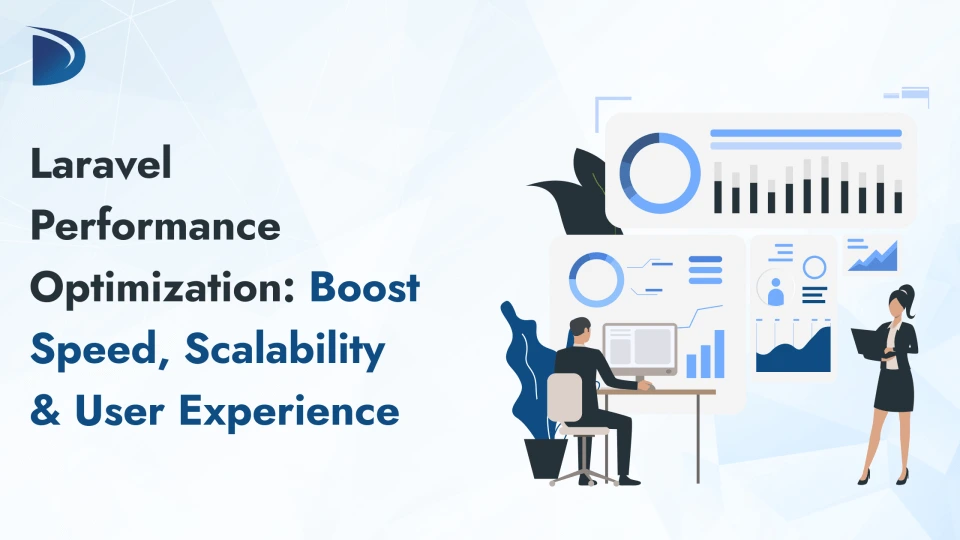Table of Contents
When your Laravel application lags, bounce rates increase and conversions decrease. That is why Laravel performance optimization is essential for user satisfaction, SEO rankings, and business growth.
At Differenz System, we help businesses develop Laravel-based web applications that are feature-rich, lightning-fast, and scalable. Find out how you can achieve this here.
Why Laravel’s Performance Matters?
Performance is no longer a basic feature to have. Studies show:
- a 1 second delay in page response can lead to a 7% drop in conversions
- Faster pages are favoured in Google’s Core Web Vitals
- Speed significantly improves user engagement
In Laravel, poor performance is usually caused by inefficient queries, bloated views, or resource-intensive synchronous tasks.
Main Laravel Performance Bottlenecks
- Slow database queries – N+1 queries, too many joins
- Uncached routes, configurations and views
- Heavy tasks running synchronously and blocking the main process
- Too many HTTP requests for asset files
- Unoptimized autoloading and dependencies
- Missing optimizations at infrastructure level such as CDN, OPCache, server tuning
1. Optimization of Database Queries
Laravel’s Eloquent ORM is powerful, but improper use can cause the dreaded N+1 query problem:
Use Eager Loading to avoid N+1 queries
Instead of:
$user = User::all();
foreach ($user as $user) {
echo $User->Profile->Bio;
}
Use:
$user = User::with(‘Profile’)->get();
Add correct indices
Make sure that columns used in WHERE, JOIN or ORDER BY clauses are indexed correctly.
Monitor Queries with Debug Tools
Use packages such as:
- Laravel Debugbar
- Telescope
These tools can display the number of queries, the execution time and the memory utilisation.
2. Optimize Laravel Caching
Caching can drastically reduce response time. Laravel offers several layers of caching:
- Route cache: php artisan route:cache
- Configuration cache: php artisan config:cache
- View cache: php artisan view:cache
Use Redis or Memcached
Set up a special caching service for sessions, views and data. Redis works smoothly with Laravel.
Response Caching
Use middleware or packages like spatie/laravel-responsecache to cache entire HTML responses for frequent views.
3. Laravel Queues for Asynchronous Tasks
Don’t keep your users waiting. Offload heavy operations to queues in the background:
- Email notifications
- Video processing
- Report generation
Use Laravel’s queuing system with drivers like Redis and manage it via Laravel Horizon.
php artisan queue:work redis
Set priorities, repetitions and monitoring alerts to ensure stability.
4. Front-end optimization starts in Laravel
Even Laravel can also help with frontend speed:
Lazy Load Assets
Only load what is needed for this view. Use:
- Laravel Mix or Vite for JS/CSS bundling
- Image lazy loading with loading=”lazy”
Minify JS and CSS
Use Laravel Mix’s mix.js() and mix.minify() for production builds.
CDN for Static Assets
Host your images, CSS and JS on a CDN to reduce load times.
5. Laravel Octane for Extreme Performance
Need extremely high performance? Enter Laravel Octane.
What it does:
- Ensures that Laravel is bootstrapped in memory
- Eliminates the cold start between requests
- Works with Swoole or RoadRunner
Benchmarks:
- Up to 10x faster than standard Laravel
- Lower memory footprint
Perfect for applications with highdata traffic, real-time systems or heavy API usage.
6. Profiling and Monitoring Tools
Continuous performance management requires transparency:
- Laravel Telescope: Inspection of requests, exceptions, queries
- Blackfire.io: Profiler for memory and CPU bottlenecks
- Xdebug: For step debugging in local environments
Set alerts for query counts, slow responses and queue errors.
7. Scaling Laravel Applications
When traffic increases, you need to scale smoothly.
Horizontal scaling
- Use Docker for containerization
- Deploy to Kubernetes for automatic scaling
DB Replication
- Read/write split with multiple DBs
- Horizontal scaling of read operations without affecting write operations
Load Balancing
Distribute the data traffic via Nginx, HAProxy or AWS ELB.
8. Edge & CDN Optimization
Deliver content closer to users to reduce latency.
Use Cloudflare or CloudFront
- Reduce the size of content during operation
- Secure APIs with WAF
- Enable caching for static files
Asset Versioning
Use the mix.version() function of Laravel Mix to resolve the cache without manual effort.
9. Advanced Laravel Middleware Optimization
Custom middleware can lead to performance degradation if not handled well.
- Apply middleware only when needed
- Group routes with common middleware
- Add cache headers via middleware for static content
10. Session Handling Techniques
Laravel supports multiple session drivers:
- Use Redis for faster session processing in production
- Store sessions in memory instead of the file system for more speed
- Configure SESSION_LIFETIME wisely to avoid frequent reads
Advanced Optimization: Laravel Octane
Octane transforms Laravel into a long-lasting application server:
- It boots the application once and keeps it in memory
- Handles thousands of requests with microsecond latency
- Ideal for APIs or backend services with high traffic
Best practices for Octane:
- Delete singletons or state in the RequestReceived event
- Use the swoole table cache driver for an ultra-fast shared data cache
- Limit maximum coroutines and monitor metrics via the /octane/metrics endpoint
- Deploy behind Nginx or Apache as a reverse proxy with HTTP/2 support
FAQs
What is Laravel performance optimization?
Optimizing Laravel means improving speed, database efficiency and resource usage through caching, query optimization, asynchronous workers, asset bundling and infrastructure improvements.
How do we optimize Eloquent queries?
Use eager loading (with()), select only required fields, add database indexes and avoid raw ORM queries for complex logic.
When should I use Laravel Octane?
Choose Octane if your application has consistent, high traffic or API endpoints that require millisecond latency, but only after you have optimized default caching and queries.
When should I choose which Optimization strategy?
- Early stage projects: start with database, caching and queries
- Medium-sized applications: enable asset minification, caching and queue offloading
- High load or API-first applications: Consider Laravel Octane with Swoole or RoadRunner after you’ve tested it properly
At Last, Performance is an Ongoing Process
Optimizing performance is not a one-off task, but an ongoing one.
- Profile regularly
- Monitoring in production
- Refactoring, if necessary
We don’t just develop Laravel applications. We develop systems that work under pressure, for start-ups and companies alike.

